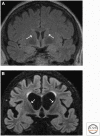Clinical Neurology and Epidemiology of the Major Neurodegenerative Diseases
- PMID: 28716886
- PMCID: PMC5880171
- DOI: 10.1101/cshperspect.a033118
Clinical Neurology and Epidemiology of the Major Neurodegenerative Diseases
Abstract
Neurodegenerative diseases are a common cause of morbidity and cognitive impairment in older adults. Most clinicians who care for the elderly are not trained to diagnose these conditions, perhaps other than typical Alzheimer's disease (AD). Each of these disorders has varied epidemiology, clinical symptomatology, laboratory and neuroimaging features, neuropathology, and management. Thus, it is important that clinicians be able to differentiate and diagnose these conditions accurately. This review summarizes and highlights clinical aspects of several of the most commonly encountered neurodegenerative diseases, including AD, frontotemporal dementia (FTD) and its variants, progressive supranuclear palsy (PSP), corticobasal degeneration (CBD), Parkinson's disease (PD), dementia with Lewy bodies (DLB), multiple system atrophy (MSA), and Huntington's disease (HD). For each condition, we provide a brief overview of the epidemiology, defining clinical symptoms and diagnostic criteria, relevant imaging and laboratory features, genetics, pathology, treatments, and differential diagnosis.
Copyright © 2018 Cold Spring Harbor Laboratory Press; all rights reserved.
Figures




References
-
- Aarsland D, Ballard C, Walker Z, Bostrom F, Alves G, Kossakowski K, Leroi I, Pozo-Rodriguez F, Minthon L, Londos E. 2009. Memantine in patients with Parkinson’s disease dementia or dementia with Lewy bodies: A double-blind, placebo-controlled, multicentre trial. Lancet Neurol 8: 613–618. - PubMed
-
- Ahmed Z, Asi YT, Sailer A, Lees AJ, Houlden H, Revesz T, Holton JL. 2012. The neuropathology, pathophysiology and genetics of multiple system atrophy. Neuropathol Appl Neurobiol 38: 4–24. - PubMed
-
- Alladi S, Xuereb J, Bak T, Nestor P, Knibb J, Patterson K, Hodges JR. 2007. Focal cortical presentations of Alzheimer’s disease. Brain 130: 2636–2645. - PubMed
-
- Alves G, Larsen JP, Emre M, Wentzel-Larsen T, Aarsland D. 2006. Changes in motor subtype and risk for incident dementia in Parkinson’s disease. Mov Disord 21: 1123–1130. - PubMed
-
- Alzheimer’s Association. 2016. 2016 Alzheimer’s disease facts and figures. Alzheimers Dement 12: 459–509. - PubMed
Publication types
MeSH terms
Grants and funding
LinkOut - more resources
Full Text Sources
Other Literature Sources
Medical
Miscellaneous
